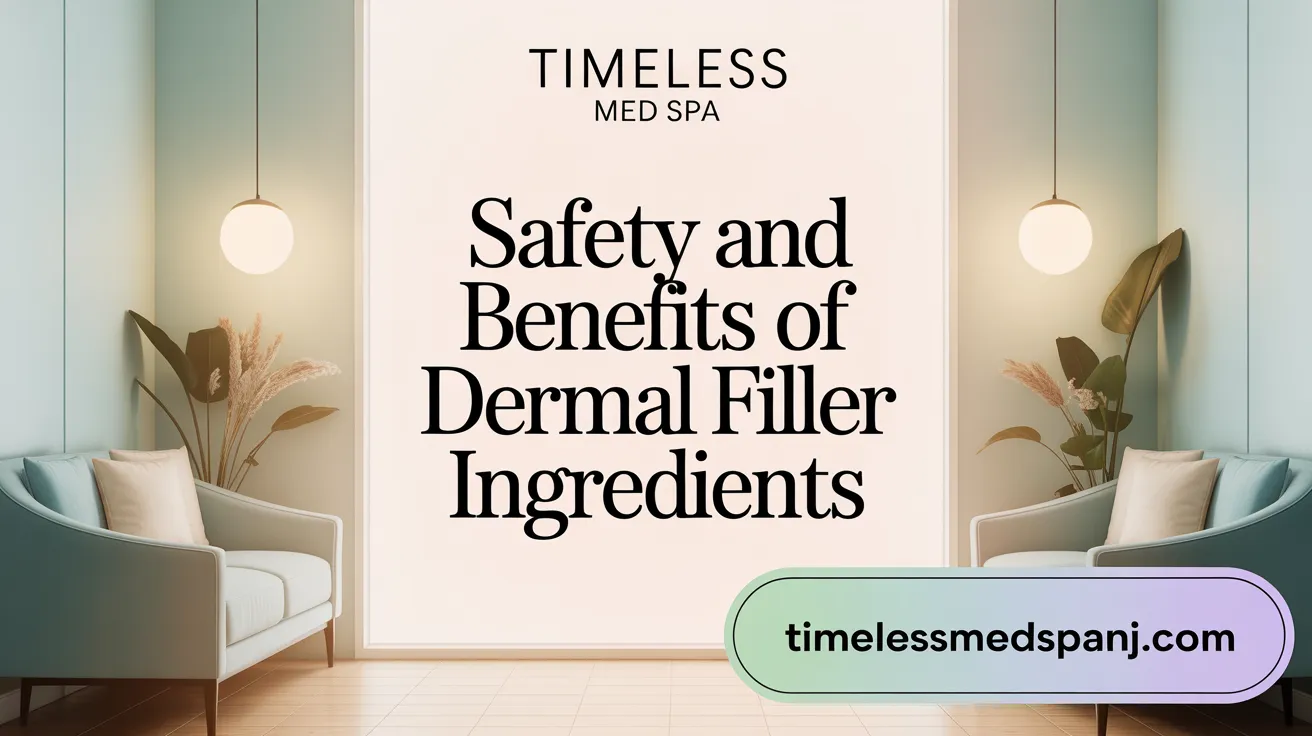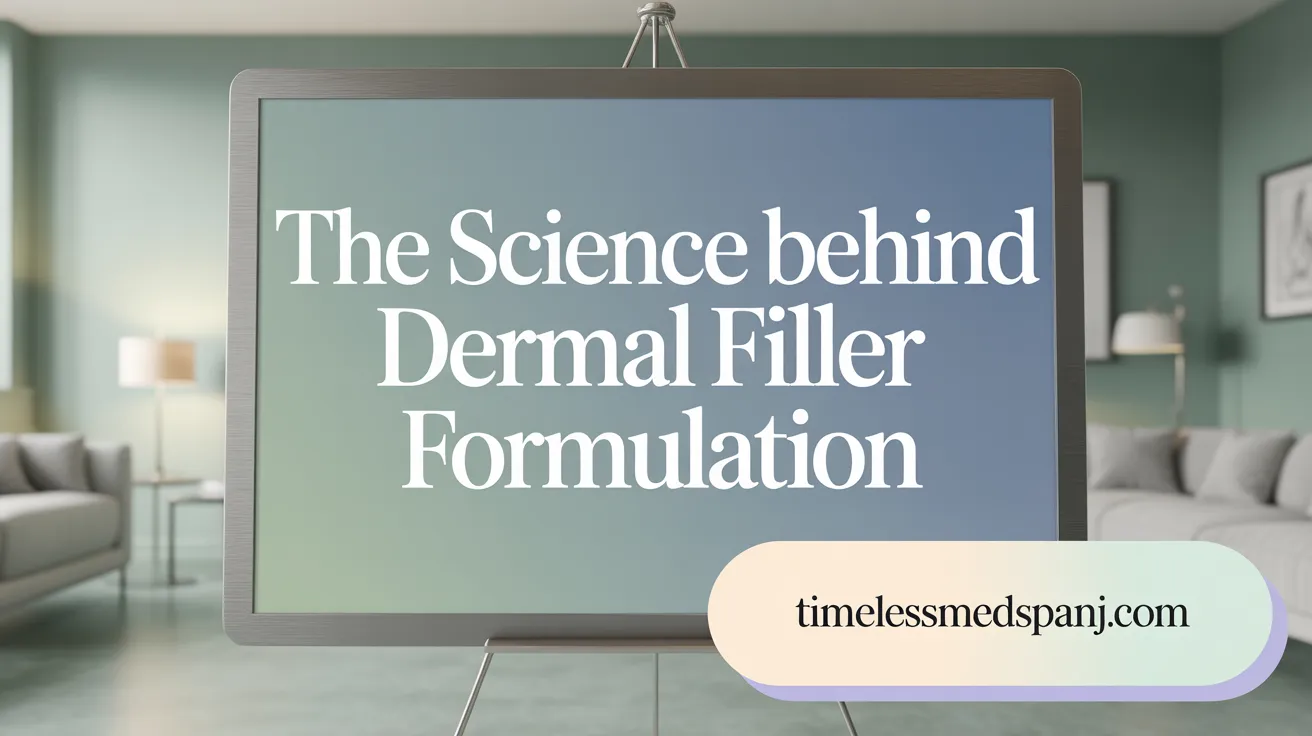Introduction to Dermal Fillers and Their Importance
Dermal fillers have transformed the landscape of cosmetic medicine by offering minimally invasive options to restore facial volume, smooth wrinkles, and enhance contours. Understanding their ingredients is vital for anyone considering these treatments, as it sheds light on how they work, their safety profiles, and their lasting effects. This article delves into the key components that make up popular dermal fillers, their properties, functioning mechanisms, and technical paradigms that underlie their formulation, giving readers a comprehensive foundation on this topic.
Basic Ingredients in Popular Dermal Fillers

What are the basic ingredients used in popular dermal fillers?
Dermal fillers are composed of various ingredients that work to restore facial volume, smooth wrinkles, and improve contours. The most common substances include hyaluronic acid, calcium hydroxylapatite, poly-L-lactic acid, and polymethylmethacrylate microspheres.
Hyaluronic acid (HA) is a natural substance found in the skin, renowned for its ability to attract and hold water, making it ideal for adding hydration and volume. It is used in many popular, FDA-approved products like JUVÉDERM® and Restylane®. HA fillers are soft, gel-like, temporary, and often infused with lidocaine, a local anesthetic that enhances patient comfort during injections.
Calcium hydroxylapatite (CaHA), present in Radiesse®, is a mineral identical to a component found naturally in bones and teeth. It offers thicker support compared to HA and stimulates the body's collagen production, which helps in treating deeper wrinkles and restoring facial volume. CaHA lasts around 12 months or longer.
Poly-L-lactic acid (PLLA), used in Sculptra®, is a biodegradable synthetic material that stimulates the body to produce new collagen over time. It is especially effective for deep facial folds and can provide results lasting up to two years. PLLA requires multiple treatment sessions for optimal results.
Polymethylmethacrylate (PMMA) microspheres are synthetic, permanent particles suspended in a collagen gel. They provide long-lasting support and are used in fillers like Bellafill®. Because of their durability, PMMA fillers are considered semi-permanent but require a skilled practitioner for safe administration.
In addition to these main ingredients, many fillers include local anesthetics such as lidocaine. This numbing agent reduces discomfort during the injection process, making the treatment more tolerable. Some formulations also combine other compounds to fine-tune properties like longevity, cohesivity, and placement suitability.
Overall, the selection of filler ingredient depends on the clinical need, desired duration of effect, and patient-specific factors. Understanding the roles of these substances helps in choosing the most appropriate treatment to achieve natural-looking outcomes while maintaining safety.
Composition and Properties of Dermal Filler Substances

What are the composition and properties of the substances used in dermal fillers?
Dermal fillers utilize a variety of biocompatible substances designed to restore volume, smooth lines, and enhance facial contours. Each material has unique chemical and physical properties that influence its performance, longevity, and application.
One of the most common substances is hyaluronic acid (HA), a naturally occurring sugar molecule found in the skin's extracellular matrix. It functions by attracting and holding water molecules—up to 1,000 times its weight—providing hydration and softness. In fillers like Juvéderm and Restylane, HA is crosslinked to create a stable gel, with the degree of crosslinking impacting its viscosity, elasticity (G′), and how long the product lasts.
Calcium hydroxylapatite (CaHA) is a mineral composition identical to bone mineral, used in Radiesse. It provides immediate support due to its particulate nature and stimulates natural collagen growth over time. CaHA particles are suspended in a gel carrier, contributing to the filler’s firmness and support.
Poly-L-lactic acid (PLLA), such as in Sculptra, is a biodegradable synthetic polymer. It stimulates the body’s collagen production gradually, leading to longer-lasting results over 2 years or more. PLLA's ability to act as a bio-stimulatory agent depends on its molecular structure and its capacity to initiate tissue regeneration.
Polymethylmethacrylate (PMMA) involves tiny microspheres encapsulated in collagen gel, providing a permanent structural support. This material's small particle size and inert nature make it suitable for deep wrinkles and scars that require long-term correction.
Autologous fat transfer involves harvesting fat from the patient’s body via liposuction and reinjecting it into areas needing volume. Its natural composition, richness in adipocytes, is advantageous for long-lasting, natural-looking results, although it can be unpredictable in terms of resorption.
How do physical and rheological properties influence filler behavior?
The performance of dermal fillers is significantly affected by their physical properties. Viscosity influences the ease of injection and the feel of the product under the skin. Elasticity (G′) determines how well the filler maintains its shape and supports tissue, especially in areas with significant movement, such as the lips.
Cohesivity refers to the ability of the gel to stick together, affecting how smoothly it integrates into tissues and its overall stability. Swelling capacity indicates how much the filler can expand when hydrated, impacting volume enhancement.
How does crosslinking and particle size impact the filler’s longevity?
Crosslinking refers to chemical bonds formed between HA molecules to increase gel durability and resistance to enzymatic breakdown, extending its life in the tissue. Higher degrees of crosslinking typically result in longer-lasting effects.
Particle size in CaHA, PLLA, and PMMA influences both the duration of results and the tissue response. Larger particles generally provide more support and longer-lasting results but may carry a higher risk of adverse reactions in sensitive areas.
What is the role of bio-stimulation in filler longevity?
Certain materials like PLLA and PCL induce the body’s natural collagen synthesis, providing a gradual and natural volumizing effect that lasts for years. This bio-stimulation extends the lifespan of the correction beyond initial volume retention, supporting sustained facial rejuvenation.
| Substance | Primary Role | Duration | Key Feature | Additional Notes |
|---|---|---|---|---|
| Hyaluronic Acid | Hydration & volume | 6-18 months | Water-binding, reversible | Naturally in skin, dissolved by hyaluronidase |
| Calcium Hydroxylapatite | Structural support & collagen stimulation | ~12 months+ | Mineral, supports deep tissues | Biocompatible, stimulates collagen |
| Poly-L-lactic Acid | Collagen stimulation | 2+ years | Biostimulatory, gradual effect | Synthetic, induces collagen |
| PMMA | Permanent support | >5 years | Microspheres in collagen | Long-term correction, permanent |
| Fat | Natural tissue replacement | Years | Autologous, natural | Requires surgical procedure |
Understanding these materials' composition and physical characteristics is essential for selecting the appropriate filler, optimizing treatment outcomes, and minimizing complications.
Mechanisms of Action: How Dermal Filler Ingredients Work

How do the ingredients in dermal fillers function and what are their mechanisms?
Dermal fillers are composed of different substances, each with unique ways of restoring facial volume and improving skin appearance. Understanding how these ingredients work helps in selecting the right treatment and managing expectations.
Hyaluronic acid (HA) is the most common filler material. It is a natural sugar molecule found in the skin’s extracellular matrix that attracts and holds water molecules—up to 1,000 times its weight. This water-binding capability creates an immediate volumizing and hydrating effect, softening wrinkles and restoring fullness. The HA gel is crosslinked using agents like BDDE to enhance durability, so it resists rapid breakdown by enzymes. Different particle sizes of HA address various wrinkle depths and areas.
Calcium hydroxylapatite (CaHA), used in Radiesse, is a mineral identical to a component in bones and teeth. When injected, CaHA microspheres suspended in a gel support tissue immediately and stimulate the body's collagen production over time. This dual action results in longer-lasting effects, often around 12 months or more.
Poly-L-lactic acid (PLLA), found in Sculptra, is a biodegradable synthetic polymer that functions as a collagen stimulator. It works by triggering a biological response that encourages the body to produce new collagen gradually. This slow process restores volume and elasticity over several weeks, with visible results lasting approximately 2 years.
Polymethylmethacrylate (PMMA), such as in Bellafill, comprises tiny microspheres suspended in a collagen gel. The microspheres serve as a scaffold, providing long-term support and maintaining tissue volume indefinitely. They stimulate tissue integration and collagen formation, resulting in more permanent facial rejuvenation.
Overall, dermal fillers combine physical filling capabilities with biological mechanisms that promote tissue regeneration. Their diverse modes of action—whether water-binding, collagen stimulation, or structural support—allow for tailored treatments that address various aging signs and cosmetic concerns.
Safety, Benefits, and Effects of Dermal Filler Components

What are the safety considerations, benefits, and effects of various dermal filler components?
Dermal fillers, when administered by qualified healthcare professionals, are a safe and effective option for facial rejuvenation. The most common ingredients include hyaluronic acid (HA), calcium hydroxylapatite (CaHA), and poly-L-lactic acid, all of which are approved by the FDA for cosmetic use.
Hyaluronic acid-based fillers are popular due to their natural presence in the skin and their ability to hydrate and create a youthful plumpness. They typically last between 6 to 18 months and can be dissolved with hyaluronidase if needed. Benefits include smoothing wrinkles, restoring volume, and improving skin contours.
Calcium hydroxylapatite, found naturally in bones, offers immediate support and stimulates collagen production. Products like Radiesse last about a year or longer and are useful for deeper wrinkles and volumizing.
Poly-L-lactic acid stimulates the body's collagen production gradually, providing results that last upwards of two years. It is ideal for addressing facial aging and hollowing.
While the benefits of these products are significant, mild side effects such as swelling, redness, bruising, or tenderness are common and typically temporary. Serious complications such as infections, allergic reactions, or vascular occlusions are rare but can be serious and require swift medical intervention.
The reversibility of HA fillers is a notable advantage, allowing for quick correction if results do not meet expectations. Conversely, synthetic fillers like CaHA, PLLA, and PMMA are more permanent and are less easily dissolved, emphasizing the importance of choosing the right product and provider.
Choosing skilled, experienced practitioners who utilize FDA-approved products minimizes risks. Proper patient consultation should include assessing facial anatomy, discussing aesthetic goals, and reviewing the provider’s credentials. This ensures the safest approach and most natural-looking results.
Overall, understanding the properties and effects of various dermal filler components helps in making informed decisions for facial enhancement and aging correction.
Comparing Hyaluronic Acid Fillers with Other Dermal Fillers

How do hyaluronic acid-based dermal fillers differ from other types of filler ingredients?
Hyaluronic acid (HA) fillers are unique because they are made from a natural sugar molecule present in our skin, which plays a crucial role in retaining moisture and supporting skin hydration. These fillers are designed to add immediate volume and smooth wrinkles by attracting water molecules, creating a plump and youthful appearance.
One of their notable advantages is the temporary nature of their effects. Most HA fillers last from six to twelve months, depending on the specific product, the injection site, and individual factors. They are also easily reversible—if a patient is unhappy with the results or experiences complications, a trained provider can dissolve the filler quickly using an enzyme called hyaluronidase.
Hyaluronic acid fillers are highly versatile. They come in various formulations, with differences in particle size and cross-linking technologies like Vycross that influence their elasticity, longevity, and suitability for different areas of the face. For instance, some are optimized for delicate areas like the lips, while others are better for cheeks or jawlines.
Compared to other filler materials, HA fillers often include a numbing agent like lidocaine to minimize discomfort during injection. Their natural and biocompatible composition also contributes to a favorable safety profile.
Other types of fillers aim for longer or permanent results. Calcium hydroxylapatite (CaHA), used in Radiesse, provides more lasting structural support—typically around a year or more—and has the added benefit of stimulating collagen production. Unlike HA fillers, CaHA is not easily dissolved if problems arise.
Synthetic options such as polymethylmethacrylate (PMMA), found in Bellafill, offer permanent correction. These involve tiny microspheres embedded in a collagen gel, providing long-lasting or permanent effects but with a different risk spectrum, including the potential for visible nodules or granulomas.
Autologous fat transfer, where a patient’s own fat is harvested and reinjected, can last for many years and even be permanent, depending on the body's response and fat survival rate. However, this procedure is more invasive and requires surgical expertise.
In summary, hyaluronic acid fillers are distinguished by their natural origin, ease of reversibility, and lower risk profile. They are typically chosen for their safety, flexibility, and the ability to adjust or dissolve treatment results quickly. In contrast, longer-lasting or permanent fillers are used when prolonged effects are desired but may carry increased risks and less flexibility for correction.
Technical and Scientific Aspects in Dermal Filler Formulation
 The formulation of dermal fillers is a complex process involving multiple scientific and technical considerations to ensure safety, effectiveness, and longevity.
The formulation of dermal fillers is a complex process involving multiple scientific and technical considerations to ensure safety, effectiveness, and longevity.
One crucial aspect is the manufacturing process of hyaluronic acid (HA), which is produced via microbial fermentation. This biotechnological process yields high-purity HA, which is then purified and chemically modified. Cross-linking agents like BDDE (1,4-butanediol diglycidyl ether) are used to stabilize HA molecules, forming a gel that resists enzymatic degradation and maintains its structural integrity in the skin.
Rheological properties such as viscosity, elasticity (quantified as storage modulus G'), and cohesivity are carefully optimized during formulation. These parameters influence how the filler interacts with tissue, its ease of injection, and how it conforms to facial contours. Techniques like controlled cross-linking, particle size regulation, and the inclusion of stabilizers help tailor these properties for specific applications, whether smooth wrinkles or augment lips.
Particle size plays a vital role in determining the filler’s performance. Smaller particles are suitable for superficial fine lines, while larger particles provide more support for deeper folds and volume restoration. Moreover, formulation processes aim to increase resistance to enzymatic breakdown, prolonging the filler’s lifespan.
Extrusion force, or the pressure needed to inject the product, is another critical parameter. It impacts clinical handling, patient comfort, and precision during procedures. Manufacturers design fillers with optimal flow characteristics to facilitate smooth injection without requiring excessive force.
Emerging technologies are set to advance the field further. Hydrogels, which mimic natural tissue by forming a network of water-retaining polymers, are gaining interest for their biocompatibility and extensive customization options. Scaffold engineering, involving the creation of biocompatible frameworks that support cell growth and tissue regeneration, opens new avenues for long-term tissue augmentation.
Additionally, combination therapies using multiple materials aim to harness the strengths of different substances—for example, pairing HA with biostimulatory agents like PLLA—to improve durability and tissue responses.
In imaging, advanced techniques assist in understanding how filler particles distribute, interact with tissue, and degrade over time, aiding in the design of more predictable and stable formulations.
Overall, the evolving science behind dermal filler development encompasses a range of disciplines, including materials science, chemistry, and biomechanics. The goal is to create formulations that provide natural-looking results with minimal side effects and prolonged effect duration, keeping pace with innovations and patient needs.
Final Thoughts on Dermal Filler Ingredients
Dermal fillers represent a sophisticated blend of natural and synthetic materials meticulously designed to restore youthful volume and smooth skin imperfections. From hyaluronic acid-based gels prized for their hydration and reversibility, to long-lasting synthetic microspheres and autologous fat transfers, each ingredient offers unique benefits and considerations. Understanding their composition, mechanisms, safety profiles, and technical formulations empowers patients and practitioners to make informed decisions tailored to individual aesthetic goals. As technology advances, ongoing innovations promise even safer, more effective, and longer-lasting dermal filler options in the future.
References
- Injectable Dermal Fillers Guide | ABCS
- Dermal Fillers
- Your Guide to Injectable Dermal Fillers
- Understanding the Ingredients of Your Injectable Treatment
- Injectable fillers: current status, physicochemical properties ...
- What's Really in Your Filler? A St. Johns County Guide to ...
- What Are Dermal Fillers Made Of? Understanding Their ...
- Fillers | Cosmetic Surgery - Stanford Medicine
- Dermal Fillers | Understanding the Different Types and Uses
- Dermal Fillers
